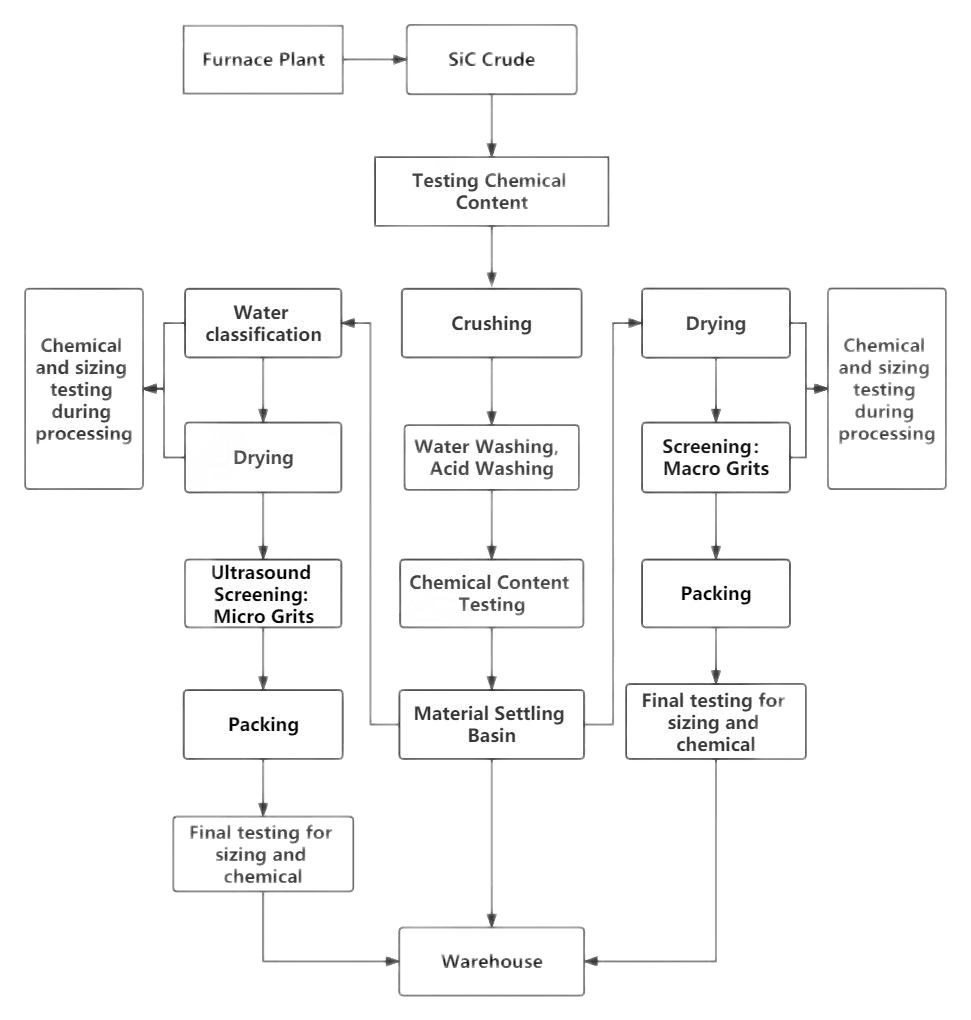กระบวนการผลิตซิลิกอนคาร์ไบด์
The manufacturing process of ซิลิคอนคาร์ไบด์ involves several steps, มั่นใจในการผลิตวัสดุคุณภาพสูงและเชื่อถือได้.
วัตถุดิบ
วัตถุดิบหลักที่ใช้ในการผลิตซิลิกอนคาร์ไบด์คือซิลิกอนและคาร์บอน. วัสดุเหล่านี้ได้รับการคัดเลือกมาอย่างดีและผ่านกระบวนการทำให้บริสุทธิ์อย่างเข้มงวดเพื่อขจัดสิ่งเจือปนและให้ได้องค์ประกอบที่ต้องการ.
การเตรียมผง
หลังจากที่วัตถุดิบได้รับการทำให้บริสุทธิ์, พวกมันจะถูกเปลี่ยนเป็นผงละเอียดด้วยเทคนิคต่างๆ. ผงซิลิกอนและคาร์บอนถูกผสมในสัดส่วนที่แม่นยำเพื่อให้ได้องค์ประกอบที่ต้องการของซิลิกอนคาร์ไบด์. จากนั้นผงจะถูกบดและบดเพื่อให้ได้ขนาดอนุภาคที่สม่ำเสมอ, รับประกันความสม่ำเสมอในผลิตภัณฑ์ขั้นสุดท้าย.
การผสมและการขึ้นรูป
ในขั้นนี้, ผงซิลิกอนคาร์ไบด์ผสมกับสารยึดเกาะและสารเติมแต่งเพื่อเพิ่มความสามารถในการทำงานและการขึ้นรูป. The mixture is then shaped into the desired form using different techniques such as pressing, extrusion, or slip casting. This step allows ผู้ผลิต to create a wide range of products, from intricate ceramic components to abrasive grains for grinding applications.
การเผา
Sintering is a critical process that involves heating the shaped silicon carbide at high temperatures, typically in a controlled atmosphere or under vacuum conditions. ระหว่างการเผา, the powders bond together, ส่งผลให้วัสดุมีความหนาแน่นและแข็งพร้อมคุณสมบัติเชิงกลที่ดีขึ้น. อุณหภูมิและระยะเวลาการเผาถูกควบคุมอย่างระมัดระวังเพื่อให้ได้ความหนาแน่นที่ต้องการและความสมบูรณ์ทางโครงสร้างของผลิตภัณฑ์ขั้นสุดท้าย.
การตกแต่งและการควบคุมคุณภาพ
หลังจากการเผา, ผลิตภัณฑ์ซิลิกอนคาร์ไบด์ผ่านกระบวนการเพิ่มเติมและขั้นสุดท้ายเพื่อตอบสนองความต้องการเฉพาะ. ซึ่งอาจรวมถึงการบด, ขัด, หรือการเคลือบผิวเพื่อให้ได้พื้นผิวที่ต้องการและความแม่นยำของมิติ. มาตรการควบคุมคุณภาพ, เช่น การตรวจสอบ, การทดสอบ, และการวิเคราะห์, are implemented throughout the manufacturing process to ensure that the silicon carbide products meet the required standards and specifications.


การประยุกต์ใช้ซิลิคอนคาร์ไบด์
Silicon carbide finds applications in a wide range of industries due to its exceptional properties and versatility. Some of the key application areas include:
Abrasives and Grinding
Silicon carbide’s exceptional hardness and abrasion resistance make it an ideal choice for abrasive materials. It is used in the production of ล้อเจียร, เครื่องมือตัด, and abrasive papers, providing superior performance and extended tool life in various machining and surface finishing operations.
Ceramics and Refractories
Silicon carbide’s high strength, excellent thermal shock resistance, and resistance to chemical attack make it a valuable material in the production of เซรามิกส์ และ refractory products. It is used in kiln furniture, เบ้าหลอม, and high-temperature components, ให้ประสิทธิภาพที่เชื่อถือได้ในสภาพแวดล้อมที่ร้อนจัดและกัดกร่อนสูง.
อิเล็กทรอนิกส์และเซมิคอนดักเตอร์
ซิลิคอนคาร์ไบด์ได้รับความสนใจอย่างมากในด้านอุปกรณ์อิเล็กทรอนิกส์และเซมิคอนดักเตอร์. คุณสมบัติทางไฟฟ้าที่เป็นเอกลักษณ์, เช่น แรงดันพังทลายสูง, การนำความร้อนสูง, และช่องว่างที่กว้าง, ทำให้เหมาะสำหรับอุปกรณ์อิเล็กทรอนิกส์กำลัง, ไฟ LED, และอุปกรณ์อิเล็กทรอนิกส์ที่มีอุณหภูมิสูง.
ยานยนต์และการขนส่ง
อุตสาหกรรมยานยนต์กำลังนำซิลิกอนคาร์ไบด์มาใช้กับงานประเภทต่างๆ มากขึ้นเรื่อยๆ. It is used in the manufacturing of components such as brake discs, clutches, and engine parts, offering superior performance, weight reduction, and improved fuel efficiency. Silicon carbide-based power electronics are also revolutionizing electric vehicle charging systems, enabling faster charging and increased power density.
Advantages and Disadvantages of Silicon Carbide
ข้อดี
- Exceptional hardness and abrasion resistance
- High thermal conductivity and heat dissipation
- Low thermal expansion and dimensional stability
- ทนต่อสารเคมีได้ดีเยี่ยม
- Wide bandgap and high-temperature operation capabilities
- Enhanced electrical properties for power electronics
ข้อเสีย
- Relatively high production cost compared to other materials
- Limited availability of large-sized components
- Processing challenges due to the hardness and brittleness of silicon carbide